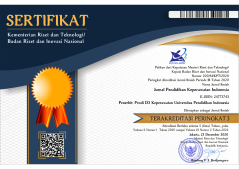KEBUTUHAN SPIRITUAL KELUARGA DENGAN ANAK PENDERITA PENYAKIT KRONIS
Abstract
ABSTRAK
Keluarga dengan anak penderita penyakit kronis membutuhkan dukungan baik secara moril maupun spiritual. Dukungan akan kebutuhan spiritual tidak jarang dianggap hal yang kurang penting. Keluarga melaporkan belum terpenuhinya kebutuhan spiritual selama menunggu anak di rumah sakit. Tujuan dari penelitian ini adalah untuk mengetahui gambaran kebutuhan spiritual manakah yang paling dibutuhkan keluarga dengan anak penderita penyakit kronis di ruang rawat inap anak RS Al Islam Bandung. Penelitian ini menggunakan deskriptif kuantitatif. Jumlah sampel 39 responden dengan teknik purposive sampling dengan kuesioner yang kembangkan dari konsep kebutuhan spiritual keluarga menurut Ruth A. Tanyi dengan nilai uji validitas 0,33-1 dan nilai reliabilitas 0,93. Analisis menggunakan analisis statistic deskriptif yang menghasilkan distribusi frekuensi serta persentase masing-masing dimensi kebutuhan. Hasil penelitian ini menunjukan bahwa dimensi dengan kebutuhan tertinggi adalah kebutuhan terhadap keyakinan (57,4%), diikuti oleh kebutuhan terhadap kekuatan (57,1%), kebutuhan terhadap family’s preference (52,3%), kebutuhan terhadap spiritual anggota keluarga (41%), kebutuhan terhadap makna dan tujuan (39%), dan kebutuhan terhadap hubungan (37,8%). Penelitian ini menunjukan bahwa dimensi kebutuhan terhadap keyakinan merupakan dimensi kebutuhan spiritual keluarga yang dirasa paling utama oleh responden. Berdasarkan hasil penelitian tersebut disarankan agar perawat dapat meningkatkan pelayanan tentang asuhan keperawatan spiritual dengan pengembangan protap dengan memasukan enam dimensi ke dalam protab yang ada, disediakan ruang tunggu yang tenang untuk keluarga dalam beribadah, adanya konseling antara perawat dan keluarga, dan menyediakan bacaan-bacaan tentang kebutuhan spiritual keluarga.
ABSTRACT
Families with children with chronic illness need support both morally and spiritually. Support for spiritual needs is not uncommonly perceived as less important. The family reported not having fulfilled the spiritual needs while waiting for the child in the hospital. The aim of this research is to know the description of spiritual needs which is most needed family with children suffering from chronic illness in the inpatient room of RS Al Islam Hospital Bandung. This research used quantitative descriptive. Total sample 39 respondents with purposive sampling technique with a questionnaire developed from the concept of spiritual family needs according to Ruth A. Tanyi with validity test value 0,33-1 and reliability value 0,93. The analysis used descriptive statistic analysis which produces frequency distribution and percentage of each need dimension. The results of this study indicate that the dimension with the highest need is the need for confidence (57.4%), followed by the need for strength (57.1%), the need for family's preference (52.3%), the need for spiritual family members (41 %), Need for meaning and purpose (39%), and need for relationship (37.8%). This study showed that the dimension of need to belief is a dimension of the spiritual needs of families that are considered most important by the respondents. Based on the results of this study it is suggested that nurses can improve the service of spiritual nursing care with the development of protap by including six dimensions into the existing protab, provided a quiet waiting room for families in worship, counseling between nurses and families, and provide readings about The spiritual needs of the family.
Keywords
Full Text:
PDFReferences
Ali, Z. (2009). Pengantar Keperawatan Keluarga. Jakarta: EGC
Alrasyid, H. 1994. Teknik Penarikan Sampel dan Penyusunan Skala. Bandung: UNPAD. www.repository.upi.edu, (diakses tanggal 28 Mei 2016).
Ardila,D & Wahyuni, S.E. (2012). Spiritualitas dan Stres Orangtua yang Mempunyai Anak Kelainan Kongenital Di RSUP H.Adam Malik. Vol 1 No 1. http://202.0.107.5/index.php/jkk/article/view/102
Arikunto, S. (2013). Prosedur Penelitian: Suatu Pendekatan Praktik. Jakarta : Rineka Cipta
Bagnasco, A.,Calza,S., Costa, M., Rosa, F.,Sasso, L. (2013). What do professionals need for an Open-Pediatric Intensive Care Unit? A focus group study on PICU professionals. Pediatric Anesthesia and Critical Care Journal,1(1):31-38.doi:10.14587/paccj. 2013.7
Behrman., Kliegman., Arvin., (1999). Ilmu Kesehatan Anak : Edisi 15. Jakarta : EGC
Benbassat, J., Pilpel, D., Tidhar, M. (2010). Patient’s Preferences for Participation in Clinical Decision Making. A Review of Published Surveys. Behavioral Medicine. Pg 81
Bert, S.C. (2011). The Influence of Religiosity and Spirituality on Adolescent Mother and Their Teenage Children. J Youth Adolescence. 40:72-84. Doi 10.1007/s10964-010-9506-9
Boyse, K., et al. (2008). Children with Chronic Conditions. http://pediatrics.aapublications.org./cgi/content/abstract/87/6/884. Diakses pada tanggal 06 Januari 2016
Büssing, A.,Bulzat HJ, Heusser, P. (2010). Spiritual Need of Patients with Chronic Pain Diseases and Cancer- Validation of The Spiritual Need Questionnaire. Eur J Med Res.15,266-273
Büssing, A & Koenig, H.G. (2010). Spiritual Needs of Patients with Chronic Disease. Religions. 1: 18-27.
Creven & Himle. (2009). Fundamental of Nursing (6th ed): Human Health and Function. Lippincot
Depkes RI. 2013. Riset Kesehatan Dasar. Jakarta: Badan Penelitian dan Pengembangan Kesehatan Kemenkes RI. Diakses pada tanggal 07 Januari 2016
Fathi, A., Azarmi, H., Elahi, T., Kateb, Z., Tarkhorani, H. (2007). The relationship between Adjustment and value system in women. MilMed Journal, 8(4),267-272.in Persian
Feudtner, C., Haney, J., Dimmers, M. A. (2003). spiritual care needs of hospitalized children and their families : a national survey of pastoral care providers perception. Pediatrics.111;e67. Doi:10.1542/peds.111.1.e67
Friedman, M. M. (1998). Keperawatan Keluarga : Teori dan Praktek (Edisi 3). Jakarta : EGC
Galek, K., Flannelly, K. J., Vane, A., Galek, R. M.,(2005). Assessing a patient’s spiritual needs a comprehensive instrument. Holistic Nurs Pract.19(2):62-69
Gallagher, S., Philips, A.C., Lee, H., Carroll, D. (2015). The Association Between Spirituality and Depression in Parents Caring for Children with Developmental Disabilities: Social Support and/or Last Resort. J Relig Health. 54:358-370. Doi 10.1007/s10943-014-9839-x
Goldman, A., Hain, R., & Stephen, L. 2012. Oxford Textbook of Palliative Care for Children Second Edition. New York: Oxford University Press.
Hamid, A.Y. (2008). Bunga Rampai Asuhan Keperawatan Kesehatan Jiwa. Jakarta: Penerbit Buku Kedokteran EGC
Hidayat, A & Alimul, A. (2008). Pengantar Konsep Dasar Keperawatan. Jakarta : Salemba Medika
Hudak & Gallo. (2010). Keperawatan Kritis : Pendekatan Holistik (Edisi 6 Volume 1). Jakarta: EGC
Ibrahim, F. A & Dykeman, C. (2010). Counseling Muslim Americans: Cultural and Spiritual Assessments. Journal of Counseling & Development.Vol 89. The American Counseling Association
Kozier, B. (2010). Buku Ajar Fundamental Keperawatan : Konsep, Proses, dan Praktik (Edisi 7 Volume 1). Jakarta : EGC
(2010). Buku Ajar Fundamental Keperawatan : Konsep, Proses, dan Praktik (Edisi 7 Volume 2). Jakarta : EGC
(2004). Fundamental of Nursing. New Jersey : person
Kusumaningrum, A. (2010). Aplikasi dan Strategi Konsep Family Centered Care Pada Anak Pra Sekolah. Jurnal Kedokteran dan Kesehatan. http://eprints.unsri.ac.id/2384/ . Diakses pada tanggal 07 Januari 2016
Kyle, T & Carman, S. (2014). Buku Ajar Keperawatan Pediatrik (Edisi 1). Jakarta : EGC
(2014). Buku Ajar Keperawatan Pediatrik (Edisi 2). Jakarta : EGC
Muscara, F., Burke, K., McCarthy, M. C., Anderson, V. A., Hearps, S.J.,Hearps, S., Dimosvski, A., Nicholson, J.M. (2015). parent distress reactions following a serious illness or injury in their child : a protocol paper for the take a breath cohort study. BMC psychiantry.15:153.doi: 10.1186/s12888-015-0519-5
Mussatto, K . (2006). Adaptation of the child and family to life with a chronic illness. Cambridge Journal. Vol 16. Pp 110-116. doi: http://dx.doi.org/10.1017/S104795110600103X
Narayansamy, A. (2004). Spiritual coping mechanism in chronically ill patients. British Journal of Nursing. University of Nottingham
National Vital Statistics System (NVSS). 2015. Death Leading Cause for 2012. NVSS.
Notoadmojo, S. (2012). Metode Penelitian Kesehatan. Jakarta: Rineka Cipta
O’Brien, M. E. (2011). Spirituality in Nursing: standing on holy ground (4th edition). USA : Jones & Bartlett Learning
Polit, D.F & Beck. (2004). Essentials of Nursing Research (Appraising Evidence for Nursing Practice). US: Lippicont William dan Wilkins
Potter, P. A., & Perry, A.G. (2005). Buku Ajar Fundamental Keperawatan : Konsep, Proses, dan Praktik (Edisi 4 vol 1). Jakarta : EGC
Purwaningsih, et al. (2013). Hubungan Perilaku Caring Perawat dengan Pemenuhan Kebutuhan Spiritual pada Pasien Rawat Inap di Rumah Sakit Umum Kaliwates PT Rolas Nusantara Medika Jember. http://repository.unej.ac.id/handle/123456789/60699. Diakses pada tanggal 13 Januari 2016
Raydian, A. (2015). Kajian Kebutuhan Keluarga Klien yang Menjalani Rawat Inap Di Ruang NICU/PICU RSUP Fatmawati
Renani, H.A., Hajinejad, F., Idani, E., Revanipour, M. (2014). Children with Asthma and Their Families’ Viewpoints on Spiritual and Psychological Resources in Adaptation with the Disease. J Relig Health. 53:1176-1189. Doi 10.1007/s10943-013-9782-2
Setiadi. (2008). Konsep & Keperawatan Keluarga. Yogyakarta: Graha Ilmu
Smith, J. 2004. Spirituality and Child Development: A concept analysis. Journal of advanced nursing. 45(3).Blackwell publishing
Soetjiningsih, & Ranuh, G. (2013). Tumbuh Kembang Anak (Edisi 2). Jakarta : EGC
Sugiyanto, B. (2014). Pengaruh Konseling Spiritual Perawat Terhadap Tingkat Kecemasan pada Keluarga Pasien yang Dirawat Di Ruang ICU RSUD Sleman Yogyakarta
Sugiyono. (2012). Metode Peneltian Pendidikan (Pendekatan Kuantitatif, Kualitatif, dan R&D). Bandung: Alfabeta
Supartini, Y. (2004). Buku Ajar Konsep Keperawatan. Yogyakarta: Graha Ilmu
Tanyi, R. A. (2002). Towards Clarification of The Meaning of Spirituality : Nursing Theory and Concept Development or Analysis. Journal of Advanced Nursing 39(5), 500-509.
(2006). Spirituality and Family Nursing : spiritual assessment and interventions for families. Journal of Advanced Nursing Vol. 53 Issue 3, p287-294. doi: 10.1111/j.1365- 2648.2006.03731.x
WHO. 2012. Palliative definition. Dalam A. Goldman, R. Hain, & L. Stephen, Oxford Text of Palliative Care for Children Second Edition (hal. 58). New York: Ocford University Press.
Widyanigsih., Petpichetchian.,dan Kitrungrote. 2014. The quality of life of Indonesian patients with advanced cancer. Songklanagarind Journal of Nursing. Volume 34, 98- 108
Wiedbusch, S.,et al. (2010). Health-realted Quality of Life, Psychosocial Strains, and Coping IN Parents of Children with Chronic Renal Failure. Pediatr Nephrol,25:1477-1485.doi: 10.1007/s00467-010-1540-z
Wilkes, L., George, A., Vickers, M.H.,Barton. B. (2008). Working and Caring for a Child eith Chronic Ilness: Barriers in Achieving Work-Family Balance. Journal of Management and Organization. pg: 59-72. doi:10.5172/jmo.2008.14.1.59
Wong, D.L dan Hockenbery-Eaton. (2000). Nursing care of infants and children (6th ed.). Missouri : Mosby
Wong, D. L., Hockenberry, M. J., & Wilson, D. (2008). Wong's Nursing Care of Infants and Children (9th ed). Missouri: Mosby.
DOI: https://doi.org/10.17509/jpki.v3i1.7480
Refbacks
- There are currently no refbacks.
Jurnal Pendidikan Keperawatan Indonesia(JPKI) published by Indonesia University of Education. JPKI is licensed under a Creative Commons Attribution-ShareAlike 4.0 International License.
Office :
Nursing Department. FPOK UPI.
229, Dr. Setiabudhi Street. Bandung 40154
West Java , Indonesia
E-mail : jpki@upi.edu

_.png)
_.png)
_.png)











